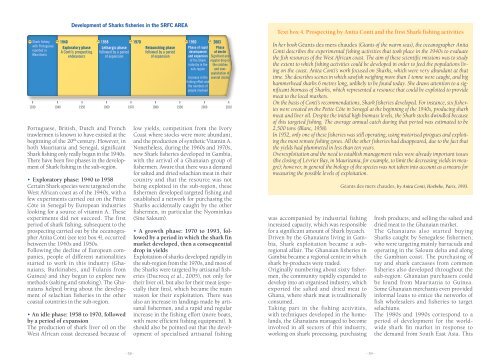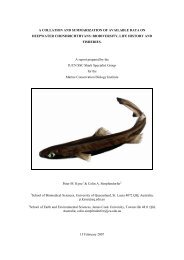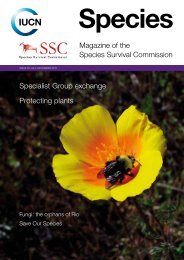30 Years of shark fishing in west africa - Shark Specialist Group
30 Years of shark fishing in west africa - Shark Specialist Group
30 Years of shark fishing in west africa - Shark Specialist Group
You also want an ePaper? Increase the reach of your titles
YUMPU automatically turns print PDFs into web optimized ePapers that Google loves.
FREIN<br />
(1979-<br />
1983)<br />
<strong>Shark</strong> fishery<br />
with Portuguese<br />
reported <strong>in</strong><br />
Mauritania<br />
19<strong>30</strong><br />
Development <strong>of</strong> <strong>Shark</strong>s fisheries <strong>in</strong> the SRFC AREA<br />
1940<br />
Exploratory phase<br />
A Conti’s prospect<strong>in</strong>g<br />
endeavours<br />
1958 1993<br />
Lethargic phase Relaunch<strong>in</strong>g phase<br />
followed by a period followed by a period<br />
<strong>of</strong> expension<br />
<strong>of</strong> expansion<br />
1970 2003<br />
Phase <strong>of</strong> rapid<br />
development<br />
and expansion<br />
<strong>of</strong> the <strong>Shark</strong><br />
<strong>in</strong>dustry <strong>in</strong> the<br />
sub-region<br />
Increase <strong>in</strong> the<br />
<strong>fish<strong>in</strong>g</strong> effort and<br />
the numbers <strong>of</strong><br />
people <strong>in</strong>volved<br />
Phase<br />
<strong>of</strong> decl<strong>in</strong><br />
Signifiant and<br />
regular drop <strong>in</strong><br />
the catches<br />
and overexploitation<br />
<strong>of</strong><br />
several stocks<br />
1940 1950 1960 1970 1980 1990 2000 2010<br />
Portuguese, British, Dutch and French<br />
trawlermen is known to have existed at the<br />
beg<strong>in</strong>n<strong>in</strong>g <strong>of</strong> the 20 th century. However, <strong>in</strong><br />
both Mauritania and Senegal, significant<br />
<strong>Shark</strong> <strong>fish<strong>in</strong>g</strong> only really began <strong>in</strong> the 1940s.<br />
There have been five phases <strong>in</strong> the development<br />
<strong>of</strong> <strong>Shark</strong> <strong>fish<strong>in</strong>g</strong> <strong>in</strong> the sub-region.<br />
• Exploratory phase: 1940 to 1958<br />
Certa<strong>in</strong> <strong>Shark</strong> species were targeted on the<br />
West African coast as <strong>of</strong> the 1940s, with a<br />
few experiments carried out on the Petite<br />
Côte <strong>in</strong> Senegal by European <strong>in</strong>dustries<br />
look<strong>in</strong>g for a source <strong>of</strong> vitam<strong>in</strong> A. These<br />
experiments did not succeed. The first<br />
period <strong>of</strong> <strong>shark</strong> <strong>fish<strong>in</strong>g</strong>, subsequent to the<br />
prospect<strong>in</strong>g carried out by the oceanographer<br />
Anita Conti (see text box 4), occurred<br />
between the 1940s and 1950s.<br />
Follow<strong>in</strong>g the decl<strong>in</strong>e <strong>of</strong> European companies,<br />
people <strong>of</strong> different nationalities<br />
started to work <strong>in</strong> this <strong>in</strong>dustry (Ghanaians,<br />
Burk<strong>in</strong>abés, and Fulanis from<br />
Gu<strong>in</strong>ea) and they begun to explore new<br />
methods (salt<strong>in</strong>g and smok<strong>in</strong>g). The Ghanaians<br />
helped br<strong>in</strong>g about the development<br />
<strong>of</strong> selachian fisheries <strong>in</strong> the other<br />
coastal countries <strong>in</strong> the sub-region.<br />
• An idle phase: 1958 to 1970, followed<br />
by a period <strong>of</strong> expansion<br />
The production <strong>of</strong> <strong>shark</strong> liver oil on the<br />
West African coast decreased because <strong>of</strong><br />
low yields, competition from the Ivory<br />
Coast where stocks were more abundant,<br />
and the production <strong>of</strong> synthetic Vitam<strong>in</strong> A.<br />
Nonetheless, dur<strong>in</strong>g the 1960s and 1970s,<br />
new <strong>Shark</strong> fisheries developed <strong>in</strong> Gambia,<br />
with the arrival <strong>of</strong> a Ghanaian group <strong>of</strong><br />
fishermen. Aware that there was a demand<br />
for salted and dried selachian meat <strong>in</strong> their<br />
country and that the resource was not<br />
be<strong>in</strong>g exploited <strong>in</strong> the sub-region, these<br />
fishermen developed targeted <strong>fish<strong>in</strong>g</strong> and<br />
established a network for purchas<strong>in</strong>g the<br />
<strong>Shark</strong>s accidentally caught by the other<br />
fishermen, <strong>in</strong> particular the Nyom<strong>in</strong>kas<br />
(S<strong>in</strong>e Saloum).<br />
• A growth phase: 1970 to 1993, followed<br />
by a period <strong>in</strong> which the <strong>shark</strong> f<strong>in</strong><br />
market developed, then a consequential<br />
drop <strong>in</strong> yields<br />
Exploitation <strong>of</strong> <strong>shark</strong>s developed rapidly <strong>in</strong><br />
the sub-region from the 1970s, and most <strong>of</strong><br />
the <strong>Shark</strong>s were targeted by artisanal fisheries<br />
(Ducrocq et al., 2005), not only for<br />
their liver oil, but also for their meat (especially<br />
their f<strong>in</strong>s), which became the ma<strong>in</strong><br />
reason for their exploitation. There was<br />
also an <strong>in</strong>crease <strong>in</strong> land<strong>in</strong>gs made by artisanal<br />
fishermen, and a rapid and regular<br />
<strong>in</strong>crease <strong>in</strong> the <strong>fish<strong>in</strong>g</strong> effort (more boats,<br />
with more efficient <strong>fish<strong>in</strong>g</strong> equipment). It<br />
should also be po<strong>in</strong>ted out that the development<br />
<strong>of</strong> specialised artisanal <strong>fish<strong>in</strong>g</strong><br />
Text box 4. Prospect<strong>in</strong>g by Anita Conti and the first <strong>Shark</strong> <strong>fish<strong>in</strong>g</strong> activities<br />
In her book Géants des mers chaudes (Giants <strong>of</strong> the warm seas), the oceanographer Anita<br />
Conti describes the experimental <strong>fish<strong>in</strong>g</strong> activities that took place <strong>in</strong> the 1940s to evaluate<br />
the fish resources <strong>of</strong> the West African coast. The aim <strong>of</strong> these scientific missions was to study<br />
the extent to which <strong>fish<strong>in</strong>g</strong> activities could be developed <strong>in</strong> order to feed the populations liv<strong>in</strong>g<br />
on the coast. Anita Conti’s work focused on <strong>Shark</strong>s, which were very abundant at that<br />
time. She describes scenes <strong>in</strong> which sawfish weigh<strong>in</strong>g more than 1 tonne were caught, and big<br />
hammerhead <strong>shark</strong>s 6 metres long, unlikely to be found today. She draws attention to a significant<br />
biomass <strong>of</strong> <strong>Shark</strong>s, which represented a resource that could be exploited to provide<br />
meat to the local markets.<br />
On the basis <strong>of</strong> Conti’s recommendations, <strong>Shark</strong> fisheries developed. For <strong>in</strong>stance, six fisheries<br />
were created on the Petite Côte <strong>in</strong> Senegal at the beg<strong>in</strong>n<strong>in</strong>g <strong>of</strong> the 1940s, produc<strong>in</strong>g <strong>shark</strong><br />
meat and liver oil. Despite the <strong>in</strong>itial high biomass levels, the <strong>Shark</strong> stocks dw<strong>in</strong>dled because<br />
<strong>of</strong> this targeted <strong>fish<strong>in</strong>g</strong>. The average annual catch dur<strong>in</strong>g that period was estimated to be<br />
2,500 tons (Blanc, 1958).<br />
In 1952, only one <strong>of</strong> these fisheries was still operat<strong>in</strong>g, us<strong>in</strong>g motorised pirogues and exploit<strong>in</strong>g<br />
the most remote <strong>fish<strong>in</strong>g</strong> zones. All the other fisheries had disappeared, due to the fact that<br />
the yields had plummeted <strong>in</strong> less than ten years.<br />
Overexploitation and the need to establish management rules were already important issues<br />
(the clos<strong>in</strong>g <strong>of</strong> Lévrier Bay, <strong>in</strong> Mauritania, for example, to limit the decreas<strong>in</strong>g yields <strong>in</strong> meagre);<br />
however, <strong>in</strong> general the biology <strong>of</strong> the species was not taken <strong>in</strong>to account as a means for<br />
measur<strong>in</strong>g the possible levels <strong>of</strong> exploitation.<br />
was accompanied by <strong>in</strong>dustrial <strong>fish<strong>in</strong>g</strong><br />
<strong>in</strong>creased capacity, which was responsible<br />
for a significant amount <strong>of</strong> <strong>Shark</strong> bycatch.<br />
Driven by the Ghanaians liv<strong>in</strong>g <strong>in</strong> Gambia,<br />
<strong>Shark</strong> exploitation became a subregional<br />
affair. The Ghanaian fisheries <strong>in</strong><br />
Gambia became a regional centre <strong>in</strong> which<br />
<strong>shark</strong> by-products were traded.<br />
Orig<strong>in</strong>ally number<strong>in</strong>g about sixty fishermen,<br />
the community rapidly expanded to<br />
develop <strong>in</strong>to an organised <strong>in</strong>dustry, which<br />
exported the salted and dried meat to<br />
Ghana, where <strong>shark</strong> meat is traditionally<br />
consumed.<br />
Tak<strong>in</strong>g part <strong>in</strong> the <strong>fish<strong>in</strong>g</strong> activities,<br />
with techniques developed <strong>in</strong> the homelands,<br />
the Ghanaians managed to become<br />
<strong>in</strong>volved <strong>in</strong> all sectors <strong>of</strong> this <strong>in</strong>dustry,<br />
work<strong>in</strong>g on <strong>shark</strong> process<strong>in</strong>g, purchas<strong>in</strong>g<br />
Géants des mers chaudes, by Anita Conti, Hoëbeke, Paris, 1993.<br />
fresh products, and sell<strong>in</strong>g the salted and<br />
dried meat to the Ghanaian market.<br />
The Ghanaians also started buy<strong>in</strong>g<br />
<strong>Shark</strong>s caught by Senegalese fishermen,<br />
who were target<strong>in</strong>g ma<strong>in</strong>ly barracuda and<br />
operat<strong>in</strong>g <strong>in</strong> the Saloum delta and along<br />
the Gambian coast. The purchas<strong>in</strong>g <strong>of</strong><br />
ray and <strong>shark</strong> carcasses from common<br />
fisheries also developed throughout the<br />
sub-region: Ghanaian purchasers could<br />
be found from Mauritania to Gu<strong>in</strong>ea.<br />
Some Ghanaian merchants even provided<br />
<strong>in</strong>formal loans to entice the networks <strong>of</strong><br />
fish wholesalers and fisheries to target<br />
selachians.<br />
The 1980s and 1990s correspond to a<br />
period <strong>of</strong> development for the worldwide<br />
<strong>shark</strong> f<strong>in</strong> market <strong>in</strong> response to<br />
the demand from South East Asia. This<br />
- 38 - - 39 -
















